North South MRT line
The North South line (NSL) is a high-capacity Mass Rapid Transit (MRT) line in Singapore, operated by SMRT. Coloured red on the rail map, the line is 45 kilometres (28 mi) long and serves 27 stations, 11 of which, between the Bishan and Marina South Pier stations, are underground. It runs from Jurong East station, located in Western Singapore, to Marina South Pier station in the Central Area, via Woodlands station in northern Singapore. The line operates for 19 hours a day (from approximately 5:30 am to around midnight), with headways of up to 3 minutes during peak hours and 7 minutes during off-peak hours. All the trains on the NSL run with a six-car formation.
North South line | |||||||||||||||||||||||||||||||||||||||||||||||||||||||||||||||||||||||||||||||||||||||||||||||||||||||||||||||||||||||||||||||||||||||||||||||||||||||||||||||||||||||||||||||||||||||||||||||||||||||||||||||||||||||||||||||||||||||||||||||||||||||||||||||||||||||||||||||||||||||||||||||||||||||||||||||||||||||||||||||||||||||||||||||||||||||||||||||||||||||||||||||||||||||||||||||||||||||||||||||||||||||||||||||||||||||
|---|---|---|---|---|---|---|---|---|---|---|---|---|---|---|---|---|---|---|---|---|---|---|---|---|---|---|---|---|---|---|---|---|---|---|---|---|---|---|---|---|---|---|---|---|---|---|---|---|---|---|---|---|---|---|---|---|---|---|---|---|---|---|---|---|---|---|---|---|---|---|---|---|---|---|---|---|---|---|---|---|---|---|---|---|---|---|---|---|---|---|---|---|---|---|---|---|---|---|---|---|---|---|---|---|---|---|---|---|---|---|---|---|---|---|---|---|---|---|---|---|---|---|---|---|---|---|---|---|---|---|---|---|---|---|---|---|---|---|---|---|---|---|---|---|---|---|---|---|---|---|---|---|---|---|---|---|---|---|---|---|---|---|---|---|---|---|---|---|---|---|---|---|---|---|---|---|---|---|---|---|---|---|---|---|---|---|---|---|---|---|---|---|---|---|---|---|---|---|---|---|---|---|---|---|---|---|---|---|---|---|---|---|---|---|---|---|---|---|---|---|---|---|---|---|---|---|---|---|---|---|---|---|---|---|---|---|---|---|---|---|---|---|---|---|---|---|---|---|---|---|---|---|---|---|---|---|---|---|---|---|---|---|---|---|---|---|---|---|---|---|---|---|---|---|---|---|---|---|---|---|---|---|---|---|---|---|---|---|---|---|---|---|---|---|---|---|---|---|---|---|---|---|---|---|---|---|---|---|---|---|---|---|---|---|---|---|---|---|---|---|---|---|---|---|---|---|---|---|---|---|---|---|---|---|---|---|---|---|---|---|---|---|---|---|---|---|---|---|---|---|---|---|---|---|---|---|---|---|---|---|---|---|---|---|---|---|---|---|---|---|---|---|---|---|---|---|---|---|---|---|---|---|---|---|---|---|---|---|---|---|---|---|---|---|---|---|---|---|---|---|---|---|---|---|---|---|---|---|---|---|---|---|---|---|---|---|---|---|---|---|---|---|---|
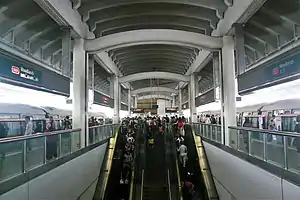 | |||||||||||||||||||||||||||||||||||||||||||||||||||||||||||||||||||||||||||||||||||||||||||||||||||||||||||||||||||||||||||||||||||||||||||||||||||||||||||||||||||||||||||||||||||||||||||||||||||||||||||||||||||||||||||||||||||||||||||||||||||||||||||||||||||||||||||||||||||||||||||||||||||||||||||||||||||||||||||||||||||||||||||||||||||||||||||||||||||||||||||||||||||||||||||||||||||||||||||||||||||||||||||||||||||||||
| Overview | |||||||||||||||||||||||||||||||||||||||||||||||||||||||||||||||||||||||||||||||||||||||||||||||||||||||||||||||||||||||||||||||||||||||||||||||||||||||||||||||||||||||||||||||||||||||||||||||||||||||||||||||||||||||||||||||||||||||||||||||||||||||||||||||||||||||||||||||||||||||||||||||||||||||||||||||||||||||||||||||||||||||||||||||||||||||||||||||||||||||||||||||||||||||||||||||||||||||||||||||||||||||||||||||||||||||
| Native name | Laluan MRT Utara Selatan 南北地铁线 வடக்கு தெற்கு எம்ஆர்டி வழி | ||||||||||||||||||||||||||||||||||||||||||||||||||||||||||||||||||||||||||||||||||||||||||||||||||||||||||||||||||||||||||||||||||||||||||||||||||||||||||||||||||||||||||||||||||||||||||||||||||||||||||||||||||||||||||||||||||||||||||||||||||||||||||||||||||||||||||||||||||||||||||||||||||||||||||||||||||||||||||||||||||||||||||||||||||||||||||||||||||||||||||||||||||||||||||||||||||||||||||||||||||||||||||||||||||||||
| Status | Operational | ||||||||||||||||||||||||||||||||||||||||||||||||||||||||||||||||||||||||||||||||||||||||||||||||||||||||||||||||||||||||||||||||||||||||||||||||||||||||||||||||||||||||||||||||||||||||||||||||||||||||||||||||||||||||||||||||||||||||||||||||||||||||||||||||||||||||||||||||||||||||||||||||||||||||||||||||||||||||||||||||||||||||||||||||||||||||||||||||||||||||||||||||||||||||||||||||||||||||||||||||||||||||||||||||||||||
| Owner | Land Transport Authority | ||||||||||||||||||||||||||||||||||||||||||||||||||||||||||||||||||||||||||||||||||||||||||||||||||||||||||||||||||||||||||||||||||||||||||||||||||||||||||||||||||||||||||||||||||||||||||||||||||||||||||||||||||||||||||||||||||||||||||||||||||||||||||||||||||||||||||||||||||||||||||||||||||||||||||||||||||||||||||||||||||||||||||||||||||||||||||||||||||||||||||||||||||||||||||||||||||||||||||||||||||||||||||||||||||||||
| Locale | Singapore | ||||||||||||||||||||||||||||||||||||||||||||||||||||||||||||||||||||||||||||||||||||||||||||||||||||||||||||||||||||||||||||||||||||||||||||||||||||||||||||||||||||||||||||||||||||||||||||||||||||||||||||||||||||||||||||||||||||||||||||||||||||||||||||||||||||||||||||||||||||||||||||||||||||||||||||||||||||||||||||||||||||||||||||||||||||||||||||||||||||||||||||||||||||||||||||||||||||||||||||||||||||||||||||||||||||||
| Termini | Jurong East Marina South Pier | ||||||||||||||||||||||||||||||||||||||||||||||||||||||||||||||||||||||||||||||||||||||||||||||||||||||||||||||||||||||||||||||||||||||||||||||||||||||||||||||||||||||||||||||||||||||||||||||||||||||||||||||||||||||||||||||||||||||||||||||||||||||||||||||||||||||||||||||||||||||||||||||||||||||||||||||||||||||||||||||||||||||||||||||||||||||||||||||||||||||||||||||||||||||||||||||||||||||||||||||||||||||||||||||||||||||
| Stations | 29 (27 in operation, 2 under planning) | ||||||||||||||||||||||||||||||||||||||||||||||||||||||||||||||||||||||||||||||||||||||||||||||||||||||||||||||||||||||||||||||||||||||||||||||||||||||||||||||||||||||||||||||||||||||||||||||||||||||||||||||||||||||||||||||||||||||||||||||||||||||||||||||||||||||||||||||||||||||||||||||||||||||||||||||||||||||||||||||||||||||||||||||||||||||||||||||||||||||||||||||||||||||||||||||||||||||||||||||||||||||||||||||||||||||
| Service | |||||||||||||||||||||||||||||||||||||||||||||||||||||||||||||||||||||||||||||||||||||||||||||||||||||||||||||||||||||||||||||||||||||||||||||||||||||||||||||||||||||||||||||||||||||||||||||||||||||||||||||||||||||||||||||||||||||||||||||||||||||||||||||||||||||||||||||||||||||||||||||||||||||||||||||||||||||||||||||||||||||||||||||||||||||||||||||||||||||||||||||||||||||||||||||||||||||||||||||||||||||||||||||||||||||||
| Type | Rapid transit | ||||||||||||||||||||||||||||||||||||||||||||||||||||||||||||||||||||||||||||||||||||||||||||||||||||||||||||||||||||||||||||||||||||||||||||||||||||||||||||||||||||||||||||||||||||||||||||||||||||||||||||||||||||||||||||||||||||||||||||||||||||||||||||||||||||||||||||||||||||||||||||||||||||||||||||||||||||||||||||||||||||||||||||||||||||||||||||||||||||||||||||||||||||||||||||||||||||||||||||||||||||||||||||||||||||||
| System | Mass Rapid Transit (Singapore) | ||||||||||||||||||||||||||||||||||||||||||||||||||||||||||||||||||||||||||||||||||||||||||||||||||||||||||||||||||||||||||||||||||||||||||||||||||||||||||||||||||||||||||||||||||||||||||||||||||||||||||||||||||||||||||||||||||||||||||||||||||||||||||||||||||||||||||||||||||||||||||||||||||||||||||||||||||||||||||||||||||||||||||||||||||||||||||||||||||||||||||||||||||||||||||||||||||||||||||||||||||||||||||||||||||||||
| Services | 1 | ||||||||||||||||||||||||||||||||||||||||||||||||||||||||||||||||||||||||||||||||||||||||||||||||||||||||||||||||||||||||||||||||||||||||||||||||||||||||||||||||||||||||||||||||||||||||||||||||||||||||||||||||||||||||||||||||||||||||||||||||||||||||||||||||||||||||||||||||||||||||||||||||||||||||||||||||||||||||||||||||||||||||||||||||||||||||||||||||||||||||||||||||||||||||||||||||||||||||||||||||||||||||||||||||||||||
| Operator(s) | SMRT Trains (SMRT Corporation) | ||||||||||||||||||||||||||||||||||||||||||||||||||||||||||||||||||||||||||||||||||||||||||||||||||||||||||||||||||||||||||||||||||||||||||||||||||||||||||||||||||||||||||||||||||||||||||||||||||||||||||||||||||||||||||||||||||||||||||||||||||||||||||||||||||||||||||||||||||||||||||||||||||||||||||||||||||||||||||||||||||||||||||||||||||||||||||||||||||||||||||||||||||||||||||||||||||||||||||||||||||||||||||||||||||||||
| Depot(s) | Bishan Ulu Pandan | ||||||||||||||||||||||||||||||||||||||||||||||||||||||||||||||||||||||||||||||||||||||||||||||||||||||||||||||||||||||||||||||||||||||||||||||||||||||||||||||||||||||||||||||||||||||||||||||||||||||||||||||||||||||||||||||||||||||||||||||||||||||||||||||||||||||||||||||||||||||||||||||||||||||||||||||||||||||||||||||||||||||||||||||||||||||||||||||||||||||||||||||||||||||||||||||||||||||||||||||||||||||||||||||||||||||
| Rolling stock | C151 C651 C751B C151A C151B C151C CR151 (Future) | ||||||||||||||||||||||||||||||||||||||||||||||||||||||||||||||||||||||||||||||||||||||||||||||||||||||||||||||||||||||||||||||||||||||||||||||||||||||||||||||||||||||||||||||||||||||||||||||||||||||||||||||||||||||||||||||||||||||||||||||||||||||||||||||||||||||||||||||||||||||||||||||||||||||||||||||||||||||||||||||||||||||||||||||||||||||||||||||||||||||||||||||||||||||||||||||||||||||||||||||||||||||||||||||||||||||
| Daily ridership | 456,323 (July 2020)[1] | ||||||||||||||||||||||||||||||||||||||||||||||||||||||||||||||||||||||||||||||||||||||||||||||||||||||||||||||||||||||||||||||||||||||||||||||||||||||||||||||||||||||||||||||||||||||||||||||||||||||||||||||||||||||||||||||||||||||||||||||||||||||||||||||||||||||||||||||||||||||||||||||||||||||||||||||||||||||||||||||||||||||||||||||||||||||||||||||||||||||||||||||||||||||||||||||||||||||||||||||||||||||||||||||||||||||
| History | |||||||||||||||||||||||||||||||||||||||||||||||||||||||||||||||||||||||||||||||||||||||||||||||||||||||||||||||||||||||||||||||||||||||||||||||||||||||||||||||||||||||||||||||||||||||||||||||||||||||||||||||||||||||||||||||||||||||||||||||||||||||||||||||||||||||||||||||||||||||||||||||||||||||||||||||||||||||||||||||||||||||||||||||||||||||||||||||||||||||||||||||||||||||||||||||||||||||||||||||||||||||||||||||||||||||
| Opened | 7 November 1987 | ||||||||||||||||||||||||||||||||||||||||||||||||||||||||||||||||||||||||||||||||||||||||||||||||||||||||||||||||||||||||||||||||||||||||||||||||||||||||||||||||||||||||||||||||||||||||||||||||||||||||||||||||||||||||||||||||||||||||||||||||||||||||||||||||||||||||||||||||||||||||||||||||||||||||||||||||||||||||||||||||||||||||||||||||||||||||||||||||||||||||||||||||||||||||||||||||||||||||||||||||||||||||||||||||||||||
| Technical | |||||||||||||||||||||||||||||||||||||||||||||||||||||||||||||||||||||||||||||||||||||||||||||||||||||||||||||||||||||||||||||||||||||||||||||||||||||||||||||||||||||||||||||||||||||||||||||||||||||||||||||||||||||||||||||||||||||||||||||||||||||||||||||||||||||||||||||||||||||||||||||||||||||||||||||||||||||||||||||||||||||||||||||||||||||||||||||||||||||||||||||||||||||||||||||||||||||||||||||||||||||||||||||||||||||||
| Line length | 45 km (28 mi) | ||||||||||||||||||||||||||||||||||||||||||||||||||||||||||||||||||||||||||||||||||||||||||||||||||||||||||||||||||||||||||||||||||||||||||||||||||||||||||||||||||||||||||||||||||||||||||||||||||||||||||||||||||||||||||||||||||||||||||||||||||||||||||||||||||||||||||||||||||||||||||||||||||||||||||||||||||||||||||||||||||||||||||||||||||||||||||||||||||||||||||||||||||||||||||||||||||||||||||||||||||||||||||||||||||||||
| Character | Elevated (Jurong East – Ang Mo Kio) Subsurface (Bishan) Underground (Braddell – Marina South Pier) | ||||||||||||||||||||||||||||||||||||||||||||||||||||||||||||||||||||||||||||||||||||||||||||||||||||||||||||||||||||||||||||||||||||||||||||||||||||||||||||||||||||||||||||||||||||||||||||||||||||||||||||||||||||||||||||||||||||||||||||||||||||||||||||||||||||||||||||||||||||||||||||||||||||||||||||||||||||||||||||||||||||||||||||||||||||||||||||||||||||||||||||||||||||||||||||||||||||||||||||||||||||||||||||||||||||||
| Track gauge | 1,435 mm (4 ft 8 1⁄2 in) standard gauge | ||||||||||||||||||||||||||||||||||||||||||||||||||||||||||||||||||||||||||||||||||||||||||||||||||||||||||||||||||||||||||||||||||||||||||||||||||||||||||||||||||||||||||||||||||||||||||||||||||||||||||||||||||||||||||||||||||||||||||||||||||||||||||||||||||||||||||||||||||||||||||||||||||||||||||||||||||||||||||||||||||||||||||||||||||||||||||||||||||||||||||||||||||||||||||||||||||||||||||||||||||||||||||||||||||||||
| Electrification | 750 V DC Third rail | ||||||||||||||||||||||||||||||||||||||||||||||||||||||||||||||||||||||||||||||||||||||||||||||||||||||||||||||||||||||||||||||||||||||||||||||||||||||||||||||||||||||||||||||||||||||||||||||||||||||||||||||||||||||||||||||||||||||||||||||||||||||||||||||||||||||||||||||||||||||||||||||||||||||||||||||||||||||||||||||||||||||||||||||||||||||||||||||||||||||||||||||||||||||||||||||||||||||||||||||||||||||||||||||||||||||
| Operating speed | limit of 80 km/h (50 mph) | ||||||||||||||||||||||||||||||||||||||||||||||||||||||||||||||||||||||||||||||||||||||||||||||||||||||||||||||||||||||||||||||||||||||||||||||||||||||||||||||||||||||||||||||||||||||||||||||||||||||||||||||||||||||||||||||||||||||||||||||||||||||||||||||||||||||||||||||||||||||||||||||||||||||||||||||||||||||||||||||||||||||||||||||||||||||||||||||||||||||||||||||||||||||||||||||||||||||||||||||||||||||||||||||||||||||
| |||||||||||||||||||||||||||||||||||||||||||||||||||||||||||||||||||||||||||||||||||||||||||||||||||||||||||||||||||||||||||||||||||||||||||||||||||||||||||||||||||||||||||||||||||||||||||||||||||||||||||||||||||||||||||||||||||||||||||||||||||||||||||||||||||||||||||||||||||||||||||||||||||||||||||||||||||||||||||||||||||||||||||||||||||||||||||||||||||||||||||||||||||||||||||||||||||||||||||||||||||||||||||||||||||||||
It is the first MRT line to be built in Singapore, with the first section from Yio Chu Kang station to Toa Payoh station beginning service on 7 November 1987, followed by an extension southwards to Raffles Place station on 12 December the same year and northwards to Yishun station on 20 December 1988. After the southern extension to Marina Bay station opened on 4 November 1989, the North South line was formed and split from the East West line. In the 1990s, the line extended to the north and west connecting to the Branch line via Woodlands through the Woodlands line extension.
Since the 2010s, due to the ageing infrastructure of the NSL (being the oldest and heavily utilised MRT line), significant improvements have been made on this line, such as the replacement of sleepers, third rail replacement and the introduction of new rolling stocks (the C151B and the C151C) to replace the older rolling stocks and increase passenger capacity. The NSL is also the first line to have undergone a major re-signalling project, converting it from semi-automatic to fully automated operations in 2019. Other recent developments of the line include a new extension to Marina South Pier station on 23 November 2014 and a new infill station, Canberra station, on 2 November 2019. Two more infill stations (Brickland and Sungei Kadut stations) on the line are being planned and are set to be opened in the 2030s.
History
Initial developments

The Mass Rapid Transit (MRT) originated from a forecast in 1967 by the planners of the State and City Planning Project,[2] which stated the need for a rail-based urban transport system in Singapore by 1992.[3][4]:66[5] Following a debate on whether a bus-only system would be more cost-effective, then-Minister for Communications Ong Teng Cheong came to the conclusion that an all-bus system would be inadequate, as it would have to compete for road space in the land-scarce country.[6][7]
After deciding on a rail-based system, the construction of what would become the North South Line was given priority as the line passes through areas having a higher demand for public transport, such as the densely populated housing estates of Toa Payoh and Ang Mo Kio and the Central Area.[8][9] Construction of the MRT line (and also the MRT system itself) started on 22 October 1983,[10] and the first section from Yio Chu Kang station to Toa Payoh station opened on 7 November 1987.[11][12] At the inauguration ceremony, Ong Teng Cheong, who backed and commissioned the planning of the MRT system, attended the ceremony as a special Guest of Honour. Dr Yeo Ning Hong, the Minister For Communications and Information, inaugurated the start of MRT operations and announced it to be the "beginning" of the MRT system.[13]
Nine more stations from Novena station to Outram Park station via Raffles Place opened on 12 December that year.[14] The line was extended northward to Yishun station on 20 December 1988 as part of phase 2B[15] and it began independent operations on 4 November 1989 as the North South line when the extension to Marina Bay station was opened.[16][17]
Woodlands extension

– Then-Prime Minister Goh Chok Tong, at the official opening of the Woodlands MRT line, on 10 February 1996.[18]
After the Branch line (from the Jurong East to Choa Chu Kang stations) opened in 1990, the Woodlands MRT line was envisioned so as to close the gap between Yishun and Choa Chu Kang stations.[19][20][21] Numerous changes were made to the number of stations for the extension mainly to accommodate the 1991 Concept Plan by the Urban Redevelopment Authority,[22][23] which aimed to make Woodlands a regional centre for northern Singapore. During the initial planning of the line, Sembawang station was only intended as a provisional station, to be built at a later date due to the underdevelopment of Sembawang, and construction began on 19 November 1992.[24] Sembawang station[25] and Kranji station[26] were later included in the construction after the second round of planning (construction began at the same time on 19 November 1992) and Sungei Kadut station was then omitted. Sungei Kadut will be built later if the town's population justifies the necessity for the station.[27]
During the construction, a total of 19 new trains were purchased for almost S$259 million for the new MRT line, designed by German company Siemens Aktiengesellschaft, to complement the 66 first generation C151 trains. There was also a need to level the land covered in thick vegetation in Kadut, Woodlands and Sembawang for the MRT line.[28]
With the official opening of the Woodlands extension on 10 February 1996 by then Prime Minister Goh Chok Tong, the Branch line was incorporated into the North South line.[20] The extension was built at a cost of $1.2 billion.[29]
Subsequent developments
| Date | Event |
|---|---|
| 7 November 1987 | Yio Chu Kang – Toa Payoh |
| 12 December 1987 | Toa Payoh – Raffles Place |
| 20 December 1988 | Yio Chu Kang – Yishun |
| 4 November 1989 | Raffles Place – Marina Bay (splitting of NSL and EWL (East West line)) |
| 10 March 1990 | Jurong East – Choa Chu Kang (as part of Branch line) |
| 10 February 1996 | Yishun – Choa Chu Kang (Woodlands line extension) |
| 23 November 2014 | Marina Bay – Marina South Pier |
| 2 November 2019 | Canberra |
| Mid-2030s | Possible opening of new infill stations Brickland and Sungei Kadut |
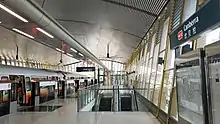
The NSL platforms of the Bishan station went through major alterations to keep up with passenger demand for the station when it interchanged with the Circle line. A new air-conditioned platform was constructed to serve the southbound trains (heading towards Marina South Pier station), and was officially opened by the then-Minister for Transport Raymond Lim on 27 July 2008. The original platform is now dedicated to northbound train services (heading towards Jurong East station), and has been also air-conditioned, but sealed off from the south-bound platform.[30]
Under the Land Transport Master Plan 2008, the Jurong East Modification Project entailed the construction of a new platform and the addition of a fourth track to Jurong East station to reduce waiting times and crowding at the station during peak hours.[31] The modification project was completed on 27 May 2011.[32] The track and platform was initially opened during morning peak hours only, but since December 2011, they also operate during the evening peak hours.[33]
In the 2008 Land Transport Master Plan, the 1-kilometre (0.6 mi) North South Line extension was announced as one of the upcoming projects rolled out by the Land Transport Authority to expand Singapore's rail network.[34] The single station extension from Marina Bay to Marina South Pier station was opened on 23 November 2014.[35][36] This extension serves the Marina South Pier, the Marina Bay Cruise Centre Singapore, and future developments in the Marina Bay Downtown area.[37]
On 17 January 2013, the Land Transport Authority (LTA) announced that a feasibility study was conducted to construct Canberra MRT station.[38][39] The feasibility study was completed in 2014 and LTA announced Canberra as a new station.[40] Construction of Canberra station commenced on 26 March 2016.[41] The station, which is an infill station with side platforms, was built along an operational section of the line between Sembawang and Yishun. The station cost S$90 million to build,[42] and is meant to serve upcoming developments at the vicinity. Canberra station opened on 2 November 2019.[43]
Incidents
On 3 March 2003, a 23-year-old man lost control of his vehicle along Lentor Avenue, crashed through the fence, and landed on a stretch of track between Yio Chu Kang and Khatib stations. The incident forced a train carrying hundreds of commuters to come to a screeching halt, but not before flattening the front of the car. The accident disrupted train services for more than three hours and cost SMRT between S$100,000 and $150,000 in damages and lost revenue.[44]
On 15 December 2011, services between Bishan and Marina Bay stations were suspended due to damage sustained on the power rail between City Hall and Dhoby Ghaut. Trains along the stretch were stalled and caused a service disruption until 11:40 pm on that day.[45][46] Two days later, a similar problem caused a seven-hour disruption between Ang Mo Kio and Marina Bay.[47][48] According to SMRT, the disruption was caused by damage to the third rail and the trains' collector shoes. Seven trains were damaged in this incident.[49] These two service disruptions on the North South line were both related to damaged rail, and became one of the worst disruption since SMRT's inception in 1987.[50]
On 7 July 2015, the North South and East West lines were temporarily disrupted due to massive power trips detected along the line. A cause of the disruption was due to damaged insulators which caused a failure to properly supply power.[51][52][53]
On 7 October 2017, a 20-hour long disruption of services started due to flooding in the tunnels between Braddell station and Bishan station due to a faulty drainage system, resulting in disruption of train services between Ang Mo Kio and Marina South Pier stations in both directions for several hours. A trackside fire between Raffles Place and Marina Bay stations further exacerbated the disruption. Train services between Marina South Pier and Newton resumed at about 9:20 pm on the same day, followed by Newton and Ang Mo Kio at around 2 pm the following day.[54] Although no injuries or casualties were reported, SMRT fired a total of eight employees from the maintenance crew, and incurred a S$2 million fine, following the incident.[55]
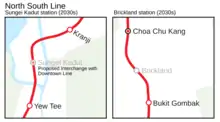
On 14 October 2020, train services from Jurong East to Woodlands stations ceased to operate for more than three and a half hours, owing to a faulty power cable, which affected the East West and Circle lines too. The power fault began at 7 pm and by 7:30 pm, commuters were stuck in the trains. Free bus bridging services were activated at all affected stations, and bus operators increased the frequency of regular services serving these areas. Service resumed at all stations along the North-South and East-West Lines at 10:35 pm.[56]
Future
In the Land Transport Master Plan 2040 (LTMP2040), two new stations are projected to be built along the existing North South Line. Brickland station will be built between Bukit Gombak and Choa Chu Kang stations, while Sungei Kadut station will be built between Yew Tee and Kranji stations and provide an additional interchange with the Downtown line. Both are expected to be completed by the mid-2030s.[57][58][59][60]
Network and operations
Services
Train services on the North South MRT line operates from approximately 5:30 am to around midnight daily. In general, during peak hours, train frequency is 2 to 3 minutes while during non-peak hours the frequency is reduced to 5 minutes throughout the entire route.[61] Each day, the first train begins service at approximately 5:15 am (5:35 am on Sundays and public holidays) from Jurong East station to Marina South Pier station. From Marina South Pier station, the first train going to Jurong East station begins service at 6:10 am (approximately 6:40 am on Sundays and public holidays). In the evenings, selected trains from Jurong East station will terminate at the Ang Mo Kio and Toa Payoh stations.[62] Selected trains departing from Marina South Pier station will also terminate at Kranji station in the late evenings.[63]
Train services on the North South Line are also subjected to maintenance and renewal works, usually on selected Fridays & Saturdays. Shuttle bus services may be provided throughout the duration of the early closures and late openings for affected commuters.[64][65] Operations of the North South Line are affected by the COVID-19 pandemic, due to the drop of ridership.[66][67]
Route
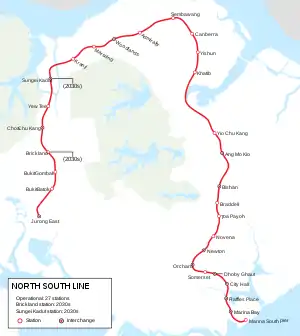
The North South line forms an incomplete loop from Jurong East in the West Region of Singapore, north to Woodlands and Sembawang, and south to the Central Area.[68] It is 45 kilometres (28 mi) long and is predominantly double-tracked, but certain short sections at the Woodlands, Yishun and Ang Mo Kio stations widen to three tracks,[69][70][71] and four tracks at Jurong East station.[72] The line begins above ground at Jurong East station[73][74] from where it continues north on a set of elevated viaducts, with the exception of a short tunnel between the Bukit Batok and Bukit Gombak stations,[75] and a surface section of track between the Bukit Gombak and Choa Chu Kang stations.[76] The line curves from the Yew Tee to Kranji stations and continues eastwards, paralleling Woodlands Avenue 3 (which the line briefly cuts underneath between Kranji and Marsiling stations)[77] and Avenue 7 main roads.[78]
After Sembawang station, the line follows the route of Canberra Link and Yishun Avenue 2, curving southwards. Between Khatib and Yio Chu Kang stations parallel to Lentor Avenue, the line continues at surface level; this section is the longest distance between any two MRT stations in Singapore.[79] The line continues above ground for the Yio Chu Kang and Ang Mo Kio stations, then it goes back to surface level for Bishan station, the MRT system's only at-grade station. A branch line to Bishan Depot exists between the Ang Mo Kio and Bishan stations.[80] After Bishan, the line goes underground through the Central Area. The North South line runs parallel to the East West line at the City Hall and Raffles Place stations, which are also cross-platform interchanges to the East West line. The line terminates at Marina South Pier.[81][74]
Stations
The line serves 27 stations across 45 kilometres (28 mi) of track, and station codes for the line are red, corresponding to the line's colour on the system map.[68][82] 11 stations, from Braddell to Marina South Pier stations, are underground, with the rest being at grade or above ground.[83] With the exception of Bishan, Braddell and Canberra stations, the other stations have island platforms.
| Station Number | Station Name | Image | Interchange/Notes |
| NS1 EW24 JE5 | Jurong East |  | This station was upgraded with new platform and new track on 27 May 2011.[84] Cross-Platform Interchange with the East West line Interchange station with the Jurong Region line (2027) |
| NS2 | Bukit Batok |  | |
| NS3 | Bukit Gombak |  | |
| NS3A | Brickland | Future infill station (mid 2030s) | |
| NS4 BP1 JS1 | Choa Chu Kang |  | Interchange station with the Bukit Panjang LRT and the Jurong Region line (2026) |
| NS5 | Yew Tee |  | |
| NS6 DT– | Sungei Kadut | Future infill station. Interchange station with the Downtown line (mid 2030s) | |
| NS7 | Kranji |  | |
| NS8 | Marsiling |  | |
| NS9 TE2 | Woodlands |  | Interchange station with the Thomson-East Coast line |
| NS10 | Admiralty |  | |
| NS11 | Sembawang |  | |
| NS12 | Canberra |  | Infill station, reduces congestion on both Yishun and Sembawang MRT Stations |
| NS13 | Yishun |  | |
| NS14 | Khatib |  | |
| NS15 | Yio Chu Kang |  | |
| NS16 CR11 | Ang Mo Kio |  | Interchange station with the Cross Island line (2029) |
| NS17 CC15 | Bishan |  | This station was upgraded since 2007 and was split into two side platforms between 27 July 2008 and 23 May 2009. Interchange station with the Circle line |
| NS18 | Braddell |  | |
| NS19 | Toa Payoh |  | |
| NS20 | Novena |  | |
| NS21 – DT11 | Newton |  | Connected to the Downtown line |
| NS22 TE14 | Orchard |  | Interchange station with the Thomson-East Coast line (2021) |
| NS23 | Somerset |  | |
| NS24 NE6 CC1 | Dhoby Ghaut |  | Interchange station with the North East and Circle lines. |
| NS25 EW13 | City Hall |  | Cross-Platform Interchange with the East West line |
| NS26 EW14 | Raffles Place |  | Cross-Platform Interchange with the East West line |
| NS27 CE2 TE20 | Marina Bay | 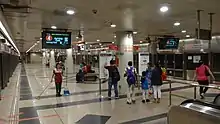 | Interchange station with the Circle line and the Thomson-East Coast line (2021) |
| NS28 | Marina South Pier | .jpg.webp) |
Infrastructure
Rolling stock
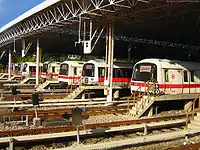
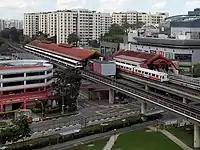
Trains on the NSL operate with a six-car formation, with an electrification of 750 V DC powered by a third rail. With the exception of the C651, the current rolling stock was manufactured by Kawasaki Heavy Industries, in a joint venture with CRRC Qingdao Sifang for the subsequent rolling stocks of the C151A, C151B and C151C.[85] When the initial line opened, the rolling stock of the North South Line consisted of C151 trains only. The C651 was introduced during the Woodlands extension to complement the existing 66 C151 trains.[86] The third-generation C751B trains were delivered in 2000.[87][88] In 2011, the fourth-generation C151A was introduced, increasing the passenger capacity of both the North South and East West lines by 15%.[89][90][91] The C151A contract was the first successful joint venture between Kawasaki Heavy Industries and CSR Qingdao Sifang in the international market.[92]
As part of efforts to further increase passenger capacity on the line, newer C151B and C151C rolling stock was subsequently delivered in 2017[93] and 2018[94] respectively. The introduction of the C151B saw the introduction of STARiS 2.0, which is also seen in subsequent rolling stocks.[95] The C151C is also the first MRT rolling stock on the NSEWL to be fitted with fold-up seats, in addition to the current features of the C151B.[96][97]
Another generation of rolling stock, the Bombardier Movia CR151, will be delivered from 2021 to 2026, to replace the C151, C651 and C751B trains which will be retired. The CR151 will be the first rolling stock on the North South line to be manufactured by Bombardier, which has also supplied trains for the Downtown MRT line.[98][99] The current rolling stock of the NSL is housed in Bishan Depot, which provides train maintenance, inspection and overhaul facilities,[100] and in Ulu Pandan Depot.[101][102]
Signalling
Initially, the North South line used a semi-automatic signalling system consisting of the Westinghouse fixed block signalling system with automatic train control under automatic train operation GoA 2.[103][104][105] However, the ageing system had undermined the rail reliability on the line, requiring the NSL to upgrade its signalling system.[106] Since 2019, the North South line is fully equipped with Thales SelTrac Communications-based train control moving block signalling system[107] with automatic train control under automatic train operation (ATO) GoA 3 (DTO).[108] The subsystems consist of automatic train protection to govern train speed, NetTrac MT Automatic Train Supervision (ATS) to track and schedule trains and a Computer-based interlocking system that prevents incorrect signal and track points to be set.[109]
A new moving-block signalling system, supplied by Thales, replaced the ageing fixed-block signalling system on the North South line. The upgrading works were completed in phases from 2016. With the upgraded signalling system, trains are now able to run closer to each other.[110][111] The new system was tested on the evening of 28 March 2017. Train services were paused for ten minutes as the old signalling system was being changed to the new system.[112] From 16 April 2017, the new system commenced full-day testing on Sundays for two months. The new C151B rolling stock were first introduced to the line on these testing days.[113] Since 28 May 2017, the new signalling system has been operating full-day on the North South line.[114] The old signalling system then ceased operations on 2 January 2019.[102]
Platform screen doors

When the line was first opened, full-height platform screen doors supplied by Westinghouse were installed at underground stations. These doors serve to prevent suicides, enable climate control within the station, better security control by restricting access to the tunnels and tracks and for overall passenger safety considerations.[115] The authorities initially rejected calls for platform screen doors to be installed at elevated stations by casting doubts over functionality and concerns about the high installation costs.[116] Nevertheless, the LTA reversed its decision and made plans to install half-height platform screen doors on elevated stations on 25 January 2008.[117][118] The first platform screen doors by ST Electronics were installed at Pasir Ris, Jurong East and Yishun stations in 2009 as trial runs.[119] Subsequently, installation began in May 2011 at Ang Mo Kio station. On 14 March 2012, platform screen doors became operational at all elevated stations on the North South line.[120]
Rail
The NSL was built with wooden sleepers, which needed to be replaced when they neared the end of their lifespan of 15 to 25 years. The replacement sleepers, made out of concrete, have a significantly longer lifespan and enable smoother and safer rides.[121] Since 2014, train services on the line have ended earlier for critical maintenance works, with the exception of a break between September 2016 and December 2017.[122]
Trains on the NSL are powered via a third rail. However, constant contact between the train's Current Collector Devices (CCD) and the line saw the need for replacement works on the third rail, which were completed in August 2017.[121][123] The new third rail replaced its 30-year-old predecessor, which was used since the opening of the line. The new electrical system is expected to make train services more reliable.[124]
References
- "Land Transport DataMall". mytransport.sg. Archived from the original on 21 August 2020. Retrieved 20 August 2020.
- "'Unique nation State' plan". The Straits Times. 20 September 1967. p. 6. Archived from the original on 15 November 2019. Retrieved 14 April 2020 – via National Library Board.
- Seah C. M. (1981). Southeast Asian Affairs. Singapore: Institute of Southeast Asian Studies. p. 293. Archived from the original on 19 September 2020. Retrieved 14 April 2020.
- Sharp, Ilsa (2005). The Journey — Singapore's Land Transport Story. SNP:Editions. ISBN 978-981-248-101-6.
- Fwa Tien Fang (4 September 2004). Sustainable Urban Transportation Planning and Development — Issues and Challenges for Singapore (Report). Department of Civil Engineering, National University of Singapore. CiteSeerX 10.1.1.119.9246.
- "1982 – The Year Work Began". Land Transport Authority. Archived from the original on 29 September 2013. Retrieved 16 November 2013.
- Lee Siew Hoon & Chandra Mohan. "In Memoriam — Ong Teng Cheong: A Profile". Channel NewsAsia. Singapore. Archived from the original on 23 February 2002. Retrieved 26 November 2007.
- Annual report / Provisional Mass Rapid Transit Authority, Republic of Singapore. Singapore: Provisional Mass Rapid Transit Authority. 1983. p. 5.
- "North-south line off first". The Straits Times. 29 August 1982. Archived from the original on 19 December 2020. Retrieved 19 December 2020.
- "Work begins on the first part of MRT system". The Straits Times. 29 October 1983. Archived from the original on 19 December 2020. Retrieved 19 December 2020.
- "All aboard for the Subway Age". The Straits Times. 8 November 1987. Archived from the original on 12 September 2017. Retrieved 3 February 2020.
- "MRT system begins operations - Singapore History". eresources.nlb.gov.sg. Archived from the original on 12 February 2020. Retrieved 8 April 2020.
- "Speech by Dr Yeo Ning Hong, Minister For Communications and Information And Second Minister For Defence (Policy), at the inauguration of public service of the MRT system at the Toa Payoh Station on Saturday, 7 November 1987 at 9.00 am" (PDF). nas.gov.sg. 7 November 1987. Archived (PDF) from the original on 19 July 2019. Retrieved 19 December 2020.
- Rav, Dhaliwal (12 December 1987). "Shopping for Xmas the MRT way..." Straits Times. Archived from the original on 24 January 2018. Retrieved 19 September 2017 – via eResources.
- "MRT Yishun opens, two-thirds of system now complete". NewspaperSG: The New Paper. 20 December 1988. p. 8. Archived from the original on 7 October 2017. Retrieved 3 February 2020.
- "New names for eight stations". Singapore Monitor. 30 November 1982.
- Dhaliwal, Rav. "East-enders get ticket to ride as MRT opens line". The Straits Times. Archived from the original on 19 September 2020. Retrieved 21 April 2020.
- Goh, Chok Tong (10 February 1996). "Speech by Prime Minister Goh Chok Tong at the Opening of Woodlands MRT Line on Saturday, 10 February 1996 at 10.00 AM" (PDF). National Archives of Singapore. Archived (PDF) from the original on 14 July 2019. Retrieved 3 February 2020.
- "MRTC considering extending line to Woodlands". The Straits Times. 11 March 1988. Archived from the original on 19 September 2020.
- "Woodlands MRT line | Infopedia". eresources.nlb.gov.sg. National Library Board. Archived from the original on 1 January 2018. Retrieved 19 September 2017.
- Leong, C. T. (26 February 1991). "Work on Woodlands MRT line to begin later this year". The Straits Times.
- "Past Concept Plans". www.ura.gov.sg. Archived from the original on 30 January 2020. Retrieved 30 January 2020.
- Living the next lap: towards a tropical city of excellence. Urban Redevelopment Authority. 1991. p. 14.
- "Better layouts for six new MRT stations". The Straits Times. 19 November 1992.
- "Another station added to Woodlands MRT line". The Straits Times. 19 November 1992.
- Thulaja, Naidu Ratnala (11 November 2003). "Kranji MRT station". National Library Board Singapore. Archived from the original on 31 December 2013. Retrieved 3 February 2012.
- "Station names for Woodlands line have ties to surroundings". The Straits Times. 20 November 1991. p. 3.
Sembawang will be in the proposed town centre of Sembawang New Town, while Kadut station will be in Sungei Kadut Industrial Estate, earmarked for redevelopment into a new town
- "Woodlands MRT closer". The Straits Times. 4 October 1994.
- "Speech by Prime Minister Goh Chok Tong at the opening of Woodlands MRT line on Saturday, 10 February 1996 at 10.00 am" (PDF). 10 February 1996. Archived (PDF) from the original on 14 July 2019.
- "New Platform at Bishan Station ready". The Straits Times. 26 July 2008.
- "Jurong East Modification Project". Archived from the original on 12 February 2012. Retrieved 31 January 2012.
- "New Platform At Jurong East Station To Open On 27 May". Land Transport Authority of Singapore. 16 May 2011. Archived from the original on 20 December 2014. Retrieved 22 November 2014.
- "New Platform At Jurong East Station To Open On 27 May | Press Room | Land Transport Authority". www.lta.gov.sg. Archived from the original on 23 September 2017. Retrieved 23 September 2017.
- "Land Transport Master Plan 2008 (Pg 34)" (PDF). lta.gov.sg. February 2008. Archived (PDF) from the original on 11 November 2012. Retrieved 8 November 2019.
- "Marina South Pier MRT Station on North-South Line to open on Sunday". The Straits Times. 22 November 2014. Archived from the original on 24 February 2018. Retrieved 8 November 2019.
- "Marina South Pier Station to Open on 23 November". lta.gov.sg. 17 November 2014. Archived from the original on 7 March 2015. Retrieved 8 November 2019.
- "North–South Line Extension | Projects | Public Transport | Land Transport Authority". www.lta.gov.sg. Archived from the original on 30 September 2012. Retrieved 19 September 2017.
- "Speech by Mr Lui Tuck Yew at visit to DTL1 Chinatown Station on 17 January 2013". MOT. 17 January 2013. Archived from the original on 26 February 2020. Retrieved 19 September 2019.
- "Two New Rail Lines And Three New Extensions To Expand Rail Network By 2030". Land Transport Authority. 17 January 2013. Archived from the original on 6 July 2014. Retrieved 1 August 2014.
- "New MRT station for North–South Line: Canberra". The Straits Times. 27 June 2014. Archived from the original on 8 August 2014. Retrieved 1 August 2014.
- "Work Starts for Canberra MRT Station on North–South Line". LTA. 26 March 2016. Archived from the original on 11 October 2017. Retrieved 11 October 2017.
- "Work starts on Canberra MRT station". Channel NewsAsia. Archived from the original on 6 March 2016. Retrieved 3 March 2016.
- "Canberra MRT station to open on Nov 2". CNA. 20 May 2019. Archived from the original on 20 May 2019. Retrieved 20 May 2019.
- "Car accident on the MRT track". RIMAS. March 2003. Archived from the original on 8 February 2012. Retrieved 3 February 2020.
- "North–South MRT line breakdown hits thousands". Channel News Asia. 15 December 2011. Archived from the original on 29 March 2012. Retrieved 17 March 2012.
- "2nd Update – SMRT statement: Service disruption on North–South Line (Northbound): Marina Bay Station to Bishan Station" (PDF). Archived from the original (PDF) on 14 April 2012.
- "MRT breaks down again". Channel NewsAsia. 17 December 2011. Archived from the original on 7 January 2012. Retrieved 17 December 2011.
- "North–South Line service resumes after 7-hour disruption". Channel NewsAsia. 17 December 2011. Archived from the original on 7 January 2012. Retrieved 17 December 2011.
- "Service disruption on North–South Line on 17 Dec 2011" (PDF). Archived from the original (PDF) on 14 April 2012.
- "Minister Updates Parliament on MRT Disruptions". Ministry Of Transport. 9 January 2012. Archived from the original on 2 July 2012.
- LTA. "Power trip on MRT network due to power fault on NSEWL". Archived from the original on 27 April 2016.
- Tan, Christopher (7 July 2015). "Full train service resumes; no suspension of North-South line at 11am". The Straits Times. Archived from the original on 23 August 2020. Retrieved 23 August 2020.
- "MRT breakdown: North-South, East-West lines down for hours". TODAYonline. 7 July 2015. Archived from the original on 23 August 2020. Retrieved 23 August 2020.
- "NSL disruption: No train services between Ang Mo Kio, Newton 'till further notice', says SMRT". Channel NewsAsia. Archived from the original on 8 October 2017. Retrieved 8 October 2017.
- "NSL disruption: Malfunctioning water pumping system resulted in flooded MRT tunnel, says LTA". Channel NewsAsia. Archived from the original on 8 October 2017. Retrieved 8 October 2017.
- hermesauto (14 October 2020). "Train services restored on North-South, East-West, Circle lines after disruption due to power fault". The Straits Times. Retrieved 15 October 2020.
- "New Sungei Kadut MRT station linking North-South and Downtown lines could shorten trips by 30 mins". The Straits Times. Archived from the original on 25 May 2019. Retrieved 25 May 2019.
- "Land Transport Master Plan 2040". www.mot.gov.sg. Archived from the original on 13 July 2019. Retrieved 11 December 2019.
- "Land Transport Master Plan 2040: Bringing Singapore Together | Press Room | Land Transport Authority". Land Transport Authority. Archived from the original on 23 August 2019. Retrieved 26 May 2019.
- "At a glance: Key updates to MRT, bus network and more for 2040 master plan". TODAYonline. 25 May 2019. Archived from the original on 25 May 2019. Retrieved 28 May 2019.
- "LTA | Getting Around | Public Transport | Rail Network". www.lta.gov.sg. Archived from the original on 1 November 2019. Retrieved 5 April 2020.
- "SMRT Journeys". journey.smrt.com.sg. Archived from the original on 4 September 2019. Retrieved 5 April 2020.
- "SMRT Journeys". journey.smrt.com.sg. Archived from the original on 19 September 2020. Retrieved 5 April 2020.
- "Early Closure of Selected North-South Line Stations from January to March 2020". www.smrt.com.sg. Archived from the original on 29 December 2019. Retrieved 5 April 2020.
- "Shortened Operating Hours for Rail Renewal Work". 1 December 2017. Archived from the original on 24 December 2019. Retrieved 5 April 2020.
- "Last train services for MRT and LRT (Annex B)" (PDF). LTA. Archived (PDF) from the original on 17 April 2020. Retrieved 15 April 2020.
- "Changes to Public Bus and Train Operating Hours and Frequency". www.lta.gov.sg. Archived from the original on 17 April 2020. Retrieved 15 April 2020.
- "North–South Line". Land Transport Authority. Archived from the original on 7 January 2017. Retrieved 24 December 2015.
- OpenStreetMap contributors (28 March 2020). "Woodlands MRT station" (Map). OpenStreetMap. Retrieved 28 March 2020.
- OpenStreetMap contributors (28 March 2020). "Yishun MRT station" (Map). OpenStreetMap. Retrieved 28 March 2020.
- OpenStreetMap contributors (28 March 2020). "Ang Mo Kio MRT station" (Map). OpenStreetMap. Retrieved 28 March 2020.
- OpenStreetMap contributors (28 March 2020). "Jurong East MRT station" (Map). OpenStreetMap. Retrieved 28 March 2020.
- "OneMap". OneMap. Archived from the original on 18 April 2020. Retrieved 24 April 2020.
- "MRT System Map" (PDF). LTA. Archived (PDF) from the original on 21 August 2020.
- OpenStreetMap contributors (28 March 2020). "Tunnel between Bukit Batok and Bukit Gombak" (Map). OpenStreetMap. Retrieved 28 March 2020.
- OpenStreetMap contributors (28 March 2020). "Surface section of track between Bukit Gombak and Choa Chu Kang" (Map). OpenStreetMap. Retrieved 28 March 2020.
- OpenStreetMap contributors (28 March 2020). "Tunnel underneath Woodlands Avenue 3" (Map). OpenStreetMap. Retrieved 28 March 2020.
- OpenStreetMap contributors (31 March 2020). "NSL along Avenue 7" (Map). OpenStreetMap. Retrieved 28 March 2020.
- OpenStreetMap contributors (28 March 2020). "Surface section of track between Khatib and Yio Chu Kang" (Map). OpenStreetMap. Retrieved 28 March 2020.
- OpenStreetMap contributors (31 March 2020). "Bishan Depot" (Map). OpenStreetMap. Retrieved 28 March 2020.
- OpenStreetMap contributors (31 March 2020). "Marina South Pier station" (Map). OpenStreetMap. Retrieved 28 March 2020.
- "North–South Line Extension". LTA. Archived from the original on 30 September 2012. Retrieved 11 October 2017.
- Singapore Bilingual Street Directory. Mighty Minds Publishing Pte Ltd. 2017. p. fold out map. ISBN 9789812501189.
- "The Jurong East Modification Project (JEMP)". Archived from the original on 27 May 2011.
- "海外向け車両 | 鉄道車両". 川崎重工業株式会社 (in Japanese). Archived from the original on 22 September 2019. Retrieved 8 April 2020.
- "$290 million contracts for Woodlands MRT line". The Straits Times. 16 August 1992.
- "EMU Trains for the Singapore Land Transport Authority". Kawasaki Heavy Industries. Archived from the original on 31 December 2012. Retrieved 5 November 2012.
- "Rapid Transit | Kawasaki Heavy Industries". global.kawasaki.com. Archived from the original on 8 April 2020. Retrieved 8 April 2020.
- "Extra metro trains for Singapore". Railway Gazette International. 7 May 2009. Archived from the original on 13 November 2009.
- "Five new trains added to boost capacity of North-South and East-West Lines" (PDF). SMRT Corporation. 16 May 2011. Archived from the original (PDF) on 27 September 2011.
- "Train capacity to rise by up to 50% in 4 years". Archived from the original on 29 February 2012. Retrieved 8 April 2020.
- "CSR Sifang and Kawasaki Heavy Industries Won the Bid in the Subway Vehicle Project of Singapore". 13 May 2009. Archived from the original on 23 July 2012. Retrieved 8 February 2012.
- "New signalling system trials extended to full day every Sunday: SMRT, LTA". Channel NewsAsia. 12 April 2017. Archived from the original on 15 April 2017. Retrieved 8 April 2020.
- "LTA Singapore Orders 12 MRT Trains (72 cars) for North-South/East-West Lines | Kawasaki Heavy Industries, Ltd". 29 April 2016. Archived from the original on 29 April 2016. Retrieved 8 June 2017.
- "SMRT Boosts Service Excellence Efforts with first Customer Experience Innovation Conference". SMRT Corporation. 21 January 2016. Archived from the original on 19 September 2020. Retrieved 8 April 2020.
- Tan, Christopher (14 August 2018). "SMRT adding 12 trains to two most heavily used lines". The Straits Times. Archived from the original on 8 April 2020.
- "LTA | News Room | News Releases | 12 More Trains to Boost Capacity of North-South and East-West Lines". www.lta.gov.sg. Archived from the original on 27 December 2019. Retrieved 15 April 2020.
- "New fleet to replace 66 oldest MRT trains from 2021". Channel NewsAsia. Archived from the original on 25 July 2018. Retrieved 25 July 2018.
- hermesauto (25 July 2018). "Bombardier awarded $1.2 billion contract to replace 66 oldest MRT trains". The Straits Times. Archived from the original on 18 December 2019. Retrieved 25 July 2018.
- "10 shortlisted for Bishan Depot deal". The Straits Times. 10 June 1984. Archived from the original on 11 October 2017. Retrieved 11 October 2017.
- "Building the MRT's third depot". The Straits Times. 17 October 1986. Archived from the original on 11 October 2017. Retrieved 11 October 2017.
- "North–South Line signalling system to take up to 6 months to stabilise". Channel NewsAsia. Archived from the original on 19 November 2017. Retrieved 11 October 2017.
- Woodland, Daniel (August 2004). "Optimisation of Automatic Train Protection Systemstion Systems" (PDF). p. Appendix C Page 32 to Page 33. Archived (PDF) from the original on 15 June 2020. Retrieved 15 June 2020.
- "Oral Reply by Minister for Transport Khaw Boon Wan to Parliamentary Question on North-South Line Resignalling". www.mot.gov.sg. Archived from the original on 16 June 2020. Retrieved 25 April 2020.
- "Communications-based train control (CBTC)". Land Transport Guru. Archived from the original on 3 December 2019. Retrieved 10 February 2020.
- "Speech by Minister Khaw Boon Wan at the Fourth Joint Forum on Infrastructure Maintenance". www.mot.gov.sg. Archived from the original on 19 September 2020. Retrieved 25 April 2020.
- "Thales awarded signalling contracts for Singapore North–South, East–West lines and Tuas West Extension". www.thalesgroup.com. Archived from the original on 20 August 2017. Retrieved 4 July 2017.
- "Metro automation facts, figures and trends" (PDF). International Association of Public Transport. Archived (PDF) from the original on 1 May 2016.
- "Thales awarded signalling contracts for Singapore North–South, East–West lines and Tuas West Extension". Thales Group. 6 February 2012. Archived from the original on 30 June 2015.
- "THALES Urban Rail Signalling Singapore – North-South / East-West Lines" (PDF). Archived (PDF) from the original on 15 June 2020. Retrieved 16 June 2020.
- LTA Website. "North–South Line Signal Upgrade". Land Transport Authority. Archived from the original on 17 June 2018. Retrieved 21 April 2017.
- "Joint Media Release by the Land Transport Authority (LTA) & SMRT - New Signalling System Trial on North-South Line Begins on 28 March 2017". LTA. 28 March 2017. Archived from the original on 19 September 2020. Retrieved 22 April 2020.
- "Factsheet by the Land Transport Authority (LTA) & SMRT: Full-day Sunday Trial of New Signalling System for North-South Line from 16 April 2017". LTA. 16 April 2017. Archived from the original on 19 September 2020. Retrieved 22 April 2020.
- "7 Questions about SMRT Trains' New Signalling System – SMRT Blog". blog.smrt.com.sg. Archived from the original on 11 October 2017. Retrieved 11 October 2017.
- Westinghouse Platform Screen Doors – Completed Projects Archived 13 February 2008 at the Wayback Machine
- "Safety at MRT and LRT Stations — Respect The Yellow line" (Press release). Land Transport Authority. 20 November 2005. Archived from the original on 27 September 2007.
- "Platform screen doors for all above-ground MRT stations by 2012". The Straits Times. 25 January 2008. Archived from the original on 28 January 2008.
- "Speech by Mr Raymond Lim, Minister for Transport, at the Visit to Kim Chuan Depot, 25 January 2008, 9.00am" (Press release). Ministry of Transport. 25 January 2008. Archived from the original on 12 January 2015. Retrieved 11 January 2015.
- Yeo Ghim Lay (3 September 2008). "Platform doors for elevated MRT stations". The Straits Times. p. 26. Archived from the original on 16 August 2009.
- "LTA completes installing elevated MRT station screen doors early". Channel NewsAsia. Archived from the original on 24 September 2017. Retrieved 23 September 2017.
- "SMRT Rail Improvements – Updates – SMRT Blog". blog.smrt.com.sg. Archived from the original on 23 September 2017. Retrieved 19 September 2017.
- "Project to replace MRT sleepers done". Archived from the original on 29 March 2017.
- "Factsheet on Power Rail Replacement Programme for the North–South and East–West Lines (NSEWL)" (PDF). Archived from the original (PDF) on 23 September 2017.
- "Third Rail Replacement on North South and East West Line". Archived from the original on 16 February 2017.